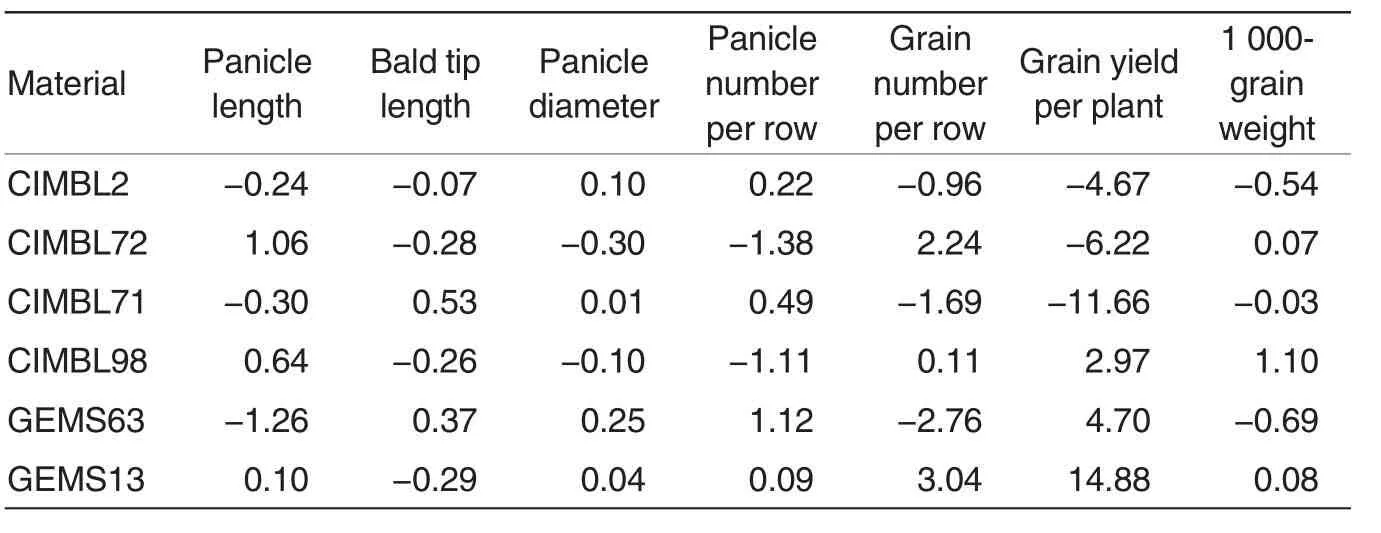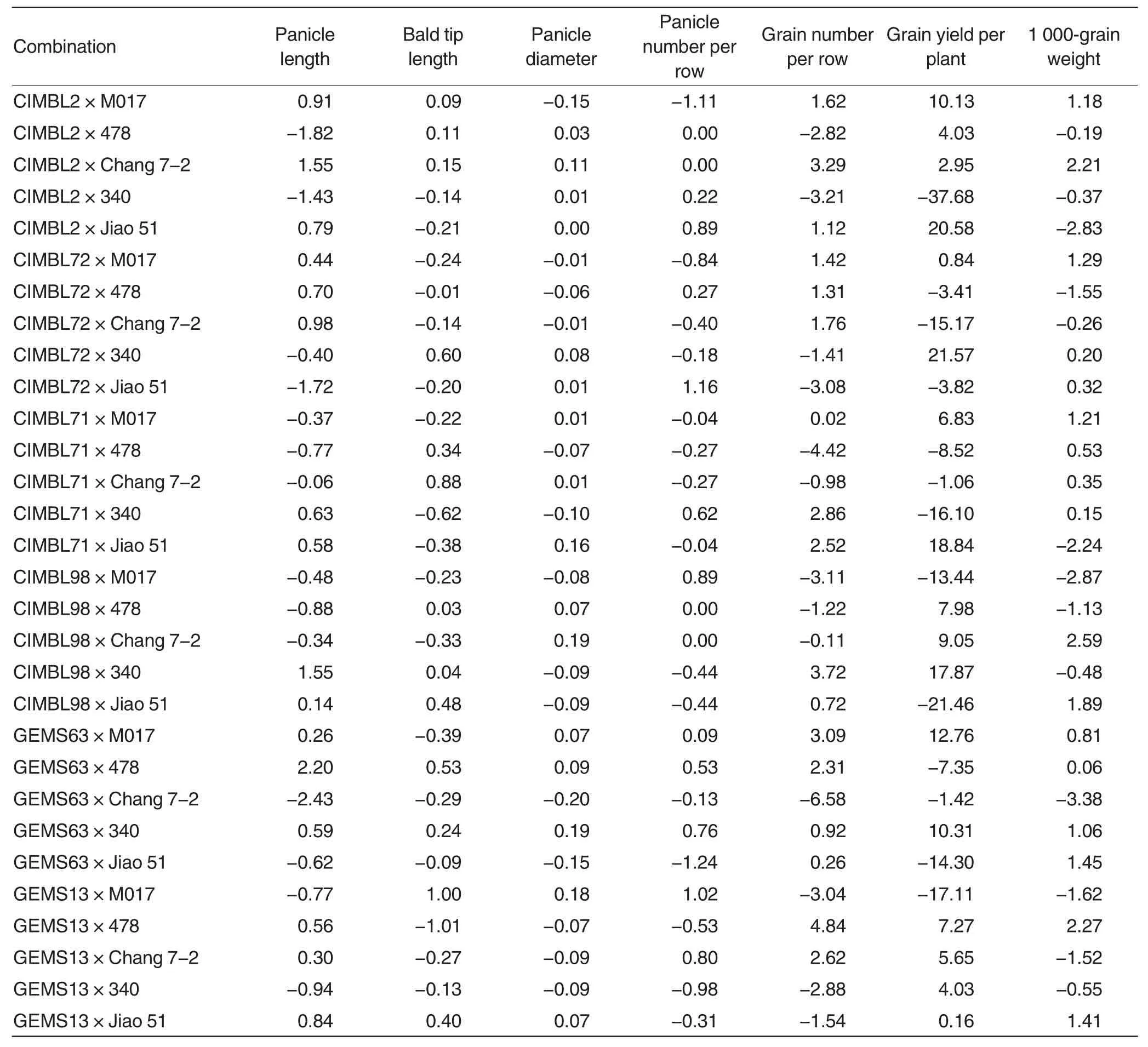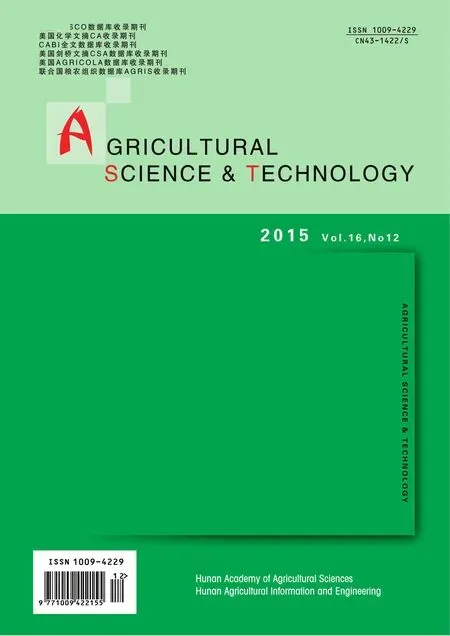Combining Ability Analysis of Panicle Traits in Six CIMMYT Maize Inbred Lines
Zhongjun FU,Shujun LI,Xin DONG,Zhiyun QI,Pihui ZHANG
Maize Research Institute,Chongqing Academy of Agricultural Sciences,Chongqing 401329,China
Narrow genetic basis of base materials is a key factor restricting maize breeding.In China,Reid,Lancaster,Lvdahonggu,Tangsipingtou and southwestlocal germplasms are commonly used in maize breeding.Studies have shown that relatively small genetic differences between different germplasms in China limit the improvement and innovation of germplasms and utilization of heterosis[1],which can be addressed by germplasm amplification.Centro Internacional de Mejoramientode Maizy Trigo (CIMMYT)has a large number of tropical and subtropical germplasm resources which are rich in abundant genetic variations with high yield potential,good stay-green trait and strong resistance[2].Therefore,introducing excellentresources from CIMMYT and clarifying the utilization directions of their heterosis is an important way to expand the existing germplasm foundation and improve the breeding efficiency of maize.In this study,yield-related traits in six CIMMYT maize germplasm resources were investigated,aiming at providing theoretical basis for the utilization of inbred lines and development of superior combinations.
Materials and Methods
Materials
Six CIMMYT maize inbred lines were used as female parental lines,including CIMBL2,CIMBL72,CIMBL71, CIMBL98, GEMS63 and GEMS13.Fiverepresentativedomestic maize inbred lines were used as male parentallines,including M017,478,Chang 7-2,340 and Jiao 51.By using an incomplete diallel cross design,30 hybrid combinations were developed to analyze the combining ability of different panicle traits.
Methods
In 2012,the experiment was carried out in Huangtian Experimental Field of Baishiyi Town,Jiulongpo District,Chongqing Municipality.A randomized block design was performed with three replications in single row plots.Each row was 2.5 m in length,and the row spacing was 0.7 m;10 seedlings were planted in each row.Five seedlings in the middle of each plot were selected for investigation.
Survey items
Seven main panicle traits were investigated,including panicle length,bald tip length,panicle diameter,panicle number per row,grain number per row,grain yield per plant,and 1 000-grain weight.
Statistical analysis
The panicle traits were analyzed with incomplete diallel cross method proposed by Liuet al.[3]and Gaoet al[4].Experimental data were analyzed using DPS 7.05 statistical software.
Results and Analysis
Variance analysis of various panicle traits in different maize varieties(lines)
According to the results of variance analysis(Table 1),various panicle traits exhibited extremely significant or significant differences between hybrid combinations,male parental lines,female parental lines or male and female parental lines.
Analysis of general combining ability effect of various panicle traits in six maize inbred lines
General combining ability(GCA)effect is determined by the additive effect of parental genotypes,which can be stably inherited and predict the performance of hybrid progenies basedon that of parents[5].Higher GCA effect of panicle traits and yield is more conducive to improving panicle traits and yield in hybrid combinations and developing high-yield hybrid combinations[6].

Table 1 The results of variance analysis of various panicle traits
According to the analysis results of GCA effect of seven panicle traits(Table 2),GCA effect varied significantly between various panicle traits in the same inbred line;GCA effect of the same trait varied remarkably between different inbred lines.GCA of grain yield per plant exhibited a positive effectin CIMBL98,GEMS63 and GEMS13,among which GCA of grain yield per plant exhibited the maximum effect in GEMS13.GCA of grain yield per plant exhibited a negative effect in CIMBL2,CIMBL72 and CIMBL71,among which GCA of grain yield per plant exhibited the maximum effect in CIMBL71.GCA of bald tip length exhibited a positive effect in CIMBL71 and GEMS63,and exhibited a negative effect in other four inbred lines.GCA of panicle length and grain number per row exhibited a positive effect in CIMBL72,CIMBL98 and GEMS13,indicating that panicle length and grain number per row in hybrid progenies of these inbred lines could be improved;GCA of panicle length and grain number per row exhibited a negative effect in other three inbred lines,indicating that panicle length and grain number per row in hybrid progenies of these inbred lines could be reduced.GCA of panicle diameter and panicle number per row exhibited a negative effect in CIMBL72 and CIMBL98,and exhibited a positive effect in other four inbred lines.
Analysis ofspecific combining ability effect of various panicle traits in hybrid combinations of different maize varieties(lines)
Specific combining ability(SCA)refers to the performance of hybrid combinations developed with the two parents that depends on the non-additive gene effects of parental geno-types,which is the deviation from the results expected on the basis of the average performance of parents in hybrid combinations.SCA is largely affected by external environmental conditions and can not be stably inherited through generations,but it can guide the use of heterosis and breeding of hybrids[7].

Table 2 General combining ability effect of various panicle traits in six maize inbred lines
As shown in Table 3,SCA effect varied significantly between various panicle traits in the same hybrid combination;SCA effect of the same trait varied remarkably between different hybrid combinations.SCA effect of grain yield per plant was relatively higher in CIMBL72×340,CIMBL2×Jiao 51,CIMBL71×Jiao 51 and CIMBL98×340,indicating that these four hybrid combinations were superior combinations.According to the SCA effect of 1 000-grain weight in hybrid combinations of different maize varieties(lines),CIMBL98×Chang 7-2,GEMS13×478 and CIMBL2×Chang 7-2 were superior combinations.
Analysis of total combining ability effect of grain yield per plant in hybrid combinations of different maize varieties(lines)
The heterosis of a hybrid combination is resulted from the sum of GCA and SCA effects in parents,namely,the total combining ability(TCA)effect.As shown in Table 4,among 30 hybrid combinations,TCA effect of grain yield per plant was relatively higherinGEMS13×Chang 7-2,CIMBL98×340,CIMBL98×Chang 7-2,GEMS13×340 and CIMBL72×340 which were developed with female parental lines CIMBL72,CIMBL98 and GEMS13.Respectively 1,2 and 2 combinations developed with these female parental lines exhibited better performance in five TCA effects;TCA effect of grain yield per plant was relatively lower in CIMBL2×340,CIMBL71×478,CIMBL72×Jiao 51,GEMS63×Jiao 51 and CIMBL71×340 which were developed with female parental lines CIMBL2,CIMBL72,CIMBL71and GEMS63.Respectively 1,1,2 and 1 combinations developed with these female parental lines exhibited better performance in five TCA effects.In addition,among 30 hybrid combinations,hybrid combinations developed with CIMBL98 and GEMS13 exhibited large positive TCA effect,indicating that these two inbred lines could be further used for combination development.

Table 3 Specific combining ability effect of various panicle traits in hybrid combinations of different maize varieties(lines)

Table 4 Total combining ability effect of grain yield per plant
Conclusion
General combining ability effect is mainly determined by the additive effect of parental genotypes,which can be stably inherited and predict the performance of hybrid progenies based on that of parents[5].In this study,the results show that inbred lines CIMBL98 and GEMS13 have excellent overall performance and great application prospects.Other materials also have certain application value in sev-eral agronomic traits and should be used selectively.Specific combining ability can guide the utilization of heterosis and breeding of hybrids.Larger SCA effect suggests more distant genetic relationship between two parents and stronger heterosis;otherwise,the parents have closer genetic relationship with no heterosis.In the present study,based on comprehensive consideration of GCA,SCA and TCA effects,CIMBL98×340 and GEMS13×Chang 7-2 are superior combinations,which require further verification.
[1]MENG YJ(孟義江),YAN JB(嚴(yán)建兵),TENG WT(滕文濤),et al.Trends in genetic diversity among widely used inbreds from 1991 to 2001 in China and application of three major germplasm groups in maize breeding (1999-2001年中國主要玉米雜交種遺傳基礎(chǔ)的變化趨勢(shì)及三大種質(zhì)類群在育種中的應(yīng)用)[J].Scientia Agricultura Sinica (中國農(nóng)業(yè)科學(xué)),2010,43(4):670-679.
[2]TALLURY SP,GOODMAN MM.Experimental evaluation of the potential of tropical germplasm for temperate maize improvement[J].Theor Appl Genet,1999,98:54-61.
[3]LIU LF(劉來福),MAO SX(毛盛賢),HUANG YZ(黃遠(yuǎn)樟).Crop Quantitative Genetics(作物數(shù)量遺傳)[M].Beijing:Agricultural Press (北京:農(nóng)業(yè)出版社),1984.
[4]GAO ZR(高之仁).Quantitative Genetics(數(shù)量遺傳學(xué))[M].Chengdu:Sichuan University Press(成都:四川大學(xué)出版社),1986.
[5]LIU ZX(劉志新),JIANG M(姜敏),WANG JJ(王金君),et al.Combining ability and utilizing value of 14 CIMMYT maize population materials(14份CIMMYT玉米群體材料配合力分析及利用價(jià)值評(píng)價(jià))[J].Journal of Maize Sciences(玉米科學(xué)),2005,13(z1):14-17,19.
[6]WANG YF(王有芳),LI SY(李少勇),WANG LH(王凌漢),et al.Analysis on the combining ability of maize ear characteristics(玉米果穗性狀的配合力分析)[J].Journal of Maize Sciences(玉米科學(xué)),2003,11(2):37-40,65.
[7]YANG KC(楊克昌),CHEN HM(陳洪梅),ZHAO ZX(趙自仙),et al.Analysis of combining ability of main characters in several key maize inbred lines(幾個(gè)玉米骨干自交系主要性狀的配合力分析)[J].Journal of Maize Sciences(玉米科學(xué)),2000,8(3):37-39,50.
 Agricultural Science & Technology2015年12期
Agricultural Science & Technology2015年12期
- Agricultural Science & Technology的其它文章
- Study on Engineering Characteristics and Application of Sticky Rice
- Periodical Development Trend of Vertical Greening
- Advances in Microbial Remediation on the Application of Heavy Metal Pollution in Agricultural Water Resources
- Analysis on Status quo and Future Development of Fruit and Vegetable Protreatment
- Effect of Three Treatment Measures on Harmless Seedling Raising of Pinus sylvestris var. mongolica Litv.
- Discussions and Recommendations for Supervision of Vegetable Quality and Safety in Miyun County
